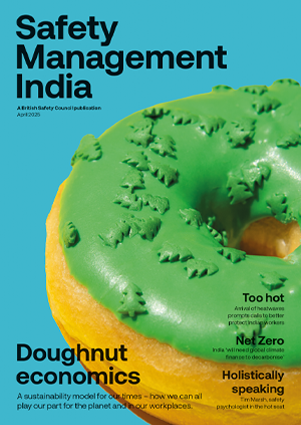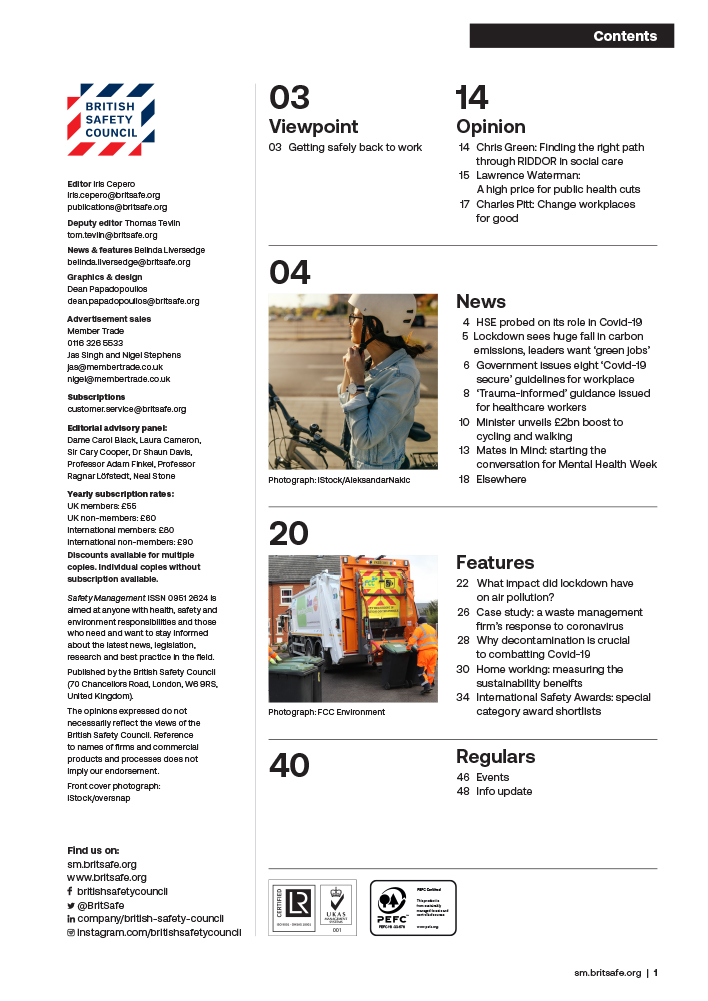Workers in the rail industry can be at particular risk of slips, trips and falls due to the diverse nature of the tasks and working environments, but the likelihood of injury can be reduced through the careful selection and provision of suitable slip-resistant footwear.
Features
Railway worker safety: the vital role of slip-resistant footwear
According to its 2022/23 Annual Health and Safety Report, the Rail Safety and Standards Board (RSSB) highlighted that, out of 83 ‘specified’ (serious) injuries sustained by the railway mainline workforce, 50 were caused by slips, trips and falls.¹ Additionally, the report revealed 4,168 workers in the rail mainline industry suffered ‘other’ injuries (over-7-day absence and non-severe injuries), due to a variety of causes, an increase of 66 injuries compared to the previous year.²
 Photograph: HAIX
Photograph: HAIX
Given the inherent risks and hazards associated with railway work, such as moving trains, heavy machinery and high-voltage equipment, the safety and wellbeing of railway workers is a vital part of keeping the network running and it’s therefore essential they are well equipped to mitigate the risk of injuries and accidents caused by slips, trips and falls.
Navigating the causes and effects of slips, trips and falls
Those working in the railway sector, whether it be maintenance workers operating on mainline tracks, maintenance staff based at train depots, station staff and train drivers, all face a daily risk of slips, trips and falls due to a variety of environmental factors. These include inadequate lighting, adverse weather conditions (such as rain, ice and snow), obstacles, distractions, slippery surfaces on tracks, platforms and ticket halls, falls during maintenance tasks, and a lack of awareness of changing railway environments.³
As a result, the workplace environment plays a major role in the level of risk of slips, trips and falls. The Health and Safety Executive’s (HSE’s) guide⁴ provides further insights into the various other factors that play a part in slipping accidents, including:
- Contamination of the floor surface by rainwater, oil and dust, and the presence of smooth surfaces like vinyl, ceramic tiles, or varnished wood, that may be particularly slippery when wet or when surface contamination is present.
- Cleaning practices, particularly when dealing with, or creating, wet floors and spillages and the hazards posed by trailing cables from electrically-powered floor cleaning equipment.
- Work practices such as rushing, distractions, negligence of duties and inadequate personal protective equipment (PPE).
- Unsuitable workplace flooring, including floor surfaces that are in poor condition due to holes and other damage, or more prone to contamination due to the poor condition of the floor, and obstructions on the floor.
- Environmental conditions such as lighting, noise levels, weather, humidity and condensation.
These risks are compounded if workers are provided with unsuitable workwear and PPE footwear, potentially leading to severe consequences for railway workers. As a result, it is essential to carefully consider the selection, provision and use of slip-resistant footwear when assessing the risk of slips, trips and falls and implementing any hazard mitigation framework in the workplace or a public environment like a railway station.
Ensuring the safety of railway workers is not only critical on a human level but it is also paramount for the efficient operation of the UK’s railway network. Accidents and injuries can lead to service disruptions, financial losses and, most importantly, cause long-term harm to individuals.
Consequences of incidents and accidents
Workforce health
Slips, trips and falls can result in a spectrum of injuries, ranging from minor sprains and strains to severe fractures, head trauma, spinal cord damage and even internal bleeding. Additionally, the psychological impact cannot be overlooked, potentially leading to anxiety, post-traumatic stress disorder (PTSD) and a fear of returning to work. Furthermore, these seemingly minor injuries can develop into significant health issues, such as musculoskeletal disorders, which is ranked among the top five reasons for sickness in the rail industry by the RSSB’s Health and Wellbeing Dashboard.⁵
Service disruptions
Workforce absenteeism stemming from injuries and accidents places significant strain on the remaining railway personnel. An injured individual requires immediate medical attention and the incident itself will require thorough investigation, both of which can disrupt the regular flow of train schedules and operations. Additionally, slips, trips and falls may cause damage to equipment, infrastructure or railway property, mandating repairs or replacements that further impedes operational efficiency. For example, if a railway worker falls while operating machinery, they may lose control of the machinery, causing damage to surroundings.
Financial losses
Slips, trips and falls in the railway industry can also lead to financial losses, encompassing the medical expenses of the injured, compensation claims, absenteeism costs and operational disruptions. Fines for companies found in breach of health and safety regulations are increasing, with some employers being ordered to pay over £1 million for safety failings resulting in workplace incidents. The diversion of financial resources originally ringfenced for improving train operations towards legal expenses and the repair and replacement of damaged equipment further compound the financial burden and compromise the industry’s financial ability to pursue general safety improvements.
Importance of footwear in mitigating slips, trips and falls
As part of improving workplace safety, the correct PPE footwear plays a vital role in helping to preventing incidents, primarily slips, trips and falls, from occurring. It is important that the PPE footwear selected is both compliant with the latest safety standards and is well-tested to maintain high quality standards. HAIX encourages opting for boots from accredited manufacturers that meet the necessary stringent standards to help prevent accidents and foster a culture of safety and accountability.
 Simon Haix is UK sales manager at HAIX. Photograph: HAIX
Simon Haix is UK sales manager at HAIX. Photograph: HAIX
Given the abundance of slip-resistant footwear options on the market, procurement officers need to be confident that the products they buy fully comply with the correct standards and have the documentation to prove this. Buying poor quality products that do not comply with the appropriate standards could put workers at risk of accidents. Moreover, purchasing higher-quality products will provide a financial benefit in the long run, as good quality footwear has a better lifespan than cheaper, inferior quality options.
When selecting appropriate PPE footwear for the workforce, a railway company should ensure that the footwear has undergone a series of quality assurance tests by the manufacturer during the development stage, including tasks that simulate the day-to-day challenges faced by workers who spend most of the day on their feet. It is essential to look for footwear with slip-resistant properties, as guaranteed by the primary safety standards of:
- EN:ISO 20345:2011 – Safety Footwear
- EN ISO 20347:2012 – Occupational (Professional) Footwear.
The latest revised and updated EN ISO 20345:2022, now applicable Europe-wide, also includes updated tests for puncture and slip resistance, ladder grips and scuff caps, enhancing overall protection against slips and trips. This new stringent anti-slip testing is compulsory for manufacturers to pass, therefore guaranteeing high quality performance standards. These certifications also guarantee that footwear meets essential professional standards based on testing across various components, such as upper, lining, tongue, outsole, insole, inlay sole and the overall footwear.
Taking a ‘one-size-fits-all’ approach to selecting PPE footwear is inappropriate as this will not take into account the variety of applications and conditions railway workers operate in. Although the most suitable footwear choice for workers must include options that are rigorously tested to ensure robust slip and puncture resistance, many workers will require footwear with additional features. For example, there may be a need for additional chainsaw protection or toe cap protection for tasks like tree surgery along railway tracks, or water or oil resistance when working on different surfaces.
Above all, comfort is an essential feature and the right footwear should offer a precise fit and enhanced ankle support for trackside environments to reduce the risk of slips and falls.
Not only is comfort important for the user experience, but the health impacts of uncomfortable footwear must also be considered. Plantar fasciitis, an acute pain in the heel caused by inflammation of the plantar fascia, is a recurring complaint from those who stand for long periods of time. Damage to the plantar fascia is the leading cause of heel pain in adults and, if left untreated, can lead to long-term health effects and pain that can negatively affect an individual’s concentration levels at work, increasing the likelihood of an accident.
However, leading footwear manufacturers are now seeking to reduce the risk of wearers developing the condition, by designing shoes and boots that support the natural curvature of the foot. This helps the wearer maintain a more natural foot position, which improves overall bodily posture and reduces wearer fatigue.
Putting your best foot forward
Given the impact of slip, trip and fall injuries, prioritising workplace safety through preventative measures is essential in mitigating the associated financial risks, maintaining operational efficiency and ensuring the wellbeing of the workforce. By investing in safety training and providing workers with high-standard, compliant PPE footwear, the rail industry can effectively decrease absences, operational disruption and additional costs due to injuries and accidents, ultimately enhancing the overall health and wellbeing of the workforce.
Simon Ash is UK sales manager at HAIX.
For more information, visit:
References
- Rail Safety and Standards Board – Annual Health and Safety Report 2022/23
- Office of Rail and Road – Rail Safety April 2022 to March 2023
- Health and Safety Executive – Causes and Prevention
- Health and Safety Executive – Causes and Prevention
- Rail Safety and Standards Board – Annual Health and Safety Report 2022/23


FEATURES

India’s path to net zero: a work in progress
By Orchie Bandyopadhyay on 08 April 2025
India is implementing a variety of clean energy measures to hit its target of net zero greenhouse gas emissions by 2070, including plans to rapidly scale up the generation of nuclear power. However, climate experts say significant finance will be required from developed countries to phase out coal power, accelerate renewables deployment and expand the national electricity grid.

Too hot to handle: early arrival of heatwaves in India sparks calls for action to protect workers and the public
By Orchie Bandyopadhyay on 08 April 2025
Temperatures in India in February 2025 were the hottest since records began over a century ago, prompting warnings the country needs to urgently step up efforts to protect both workers and the general population from the health risks posed by extreme heat and humidity.

